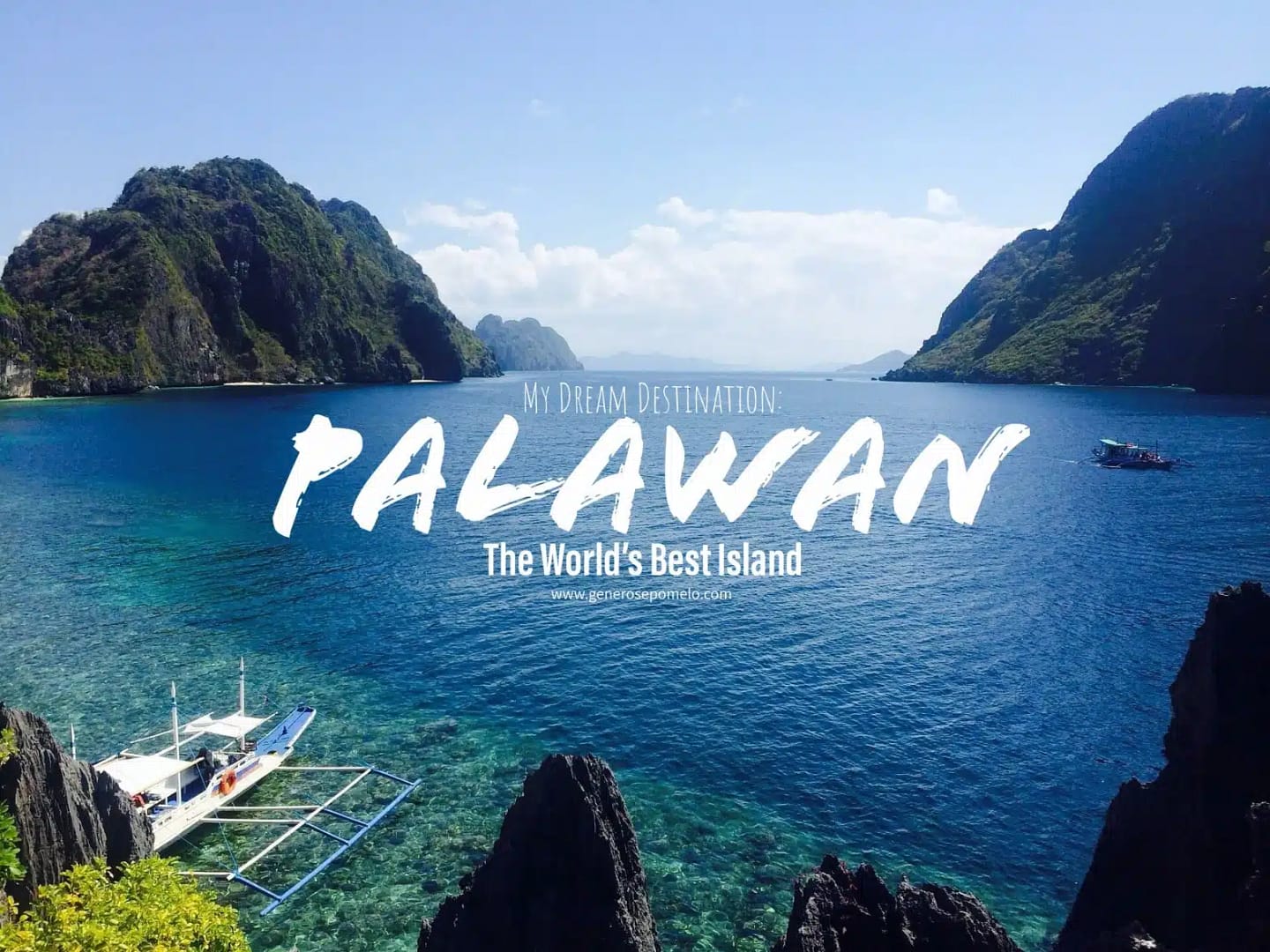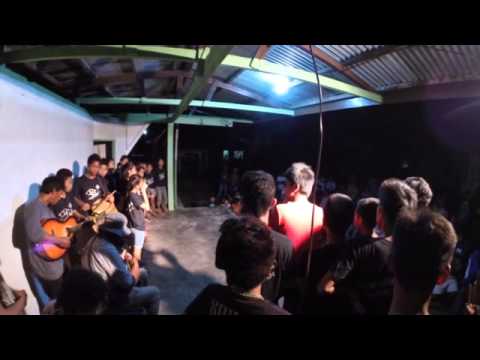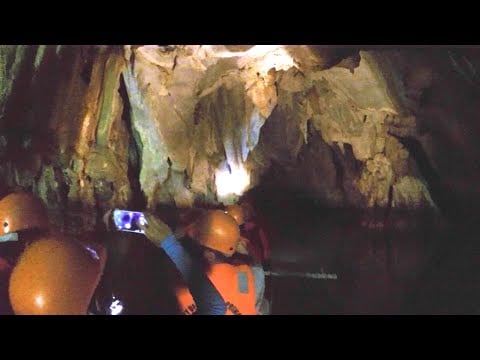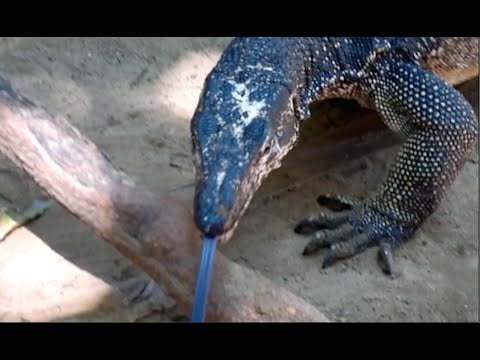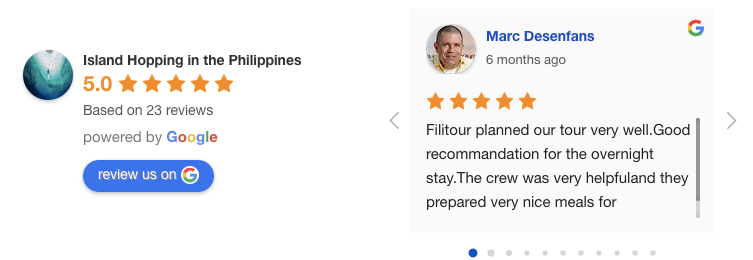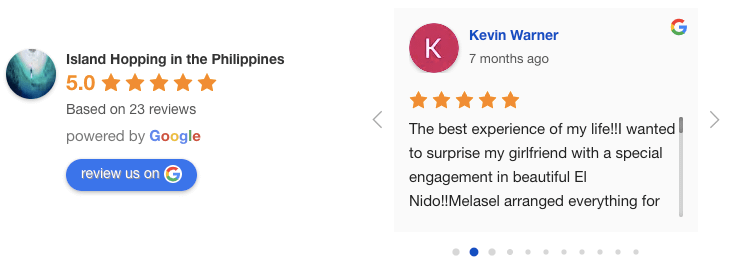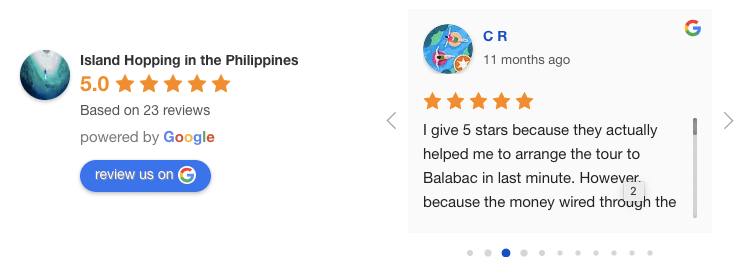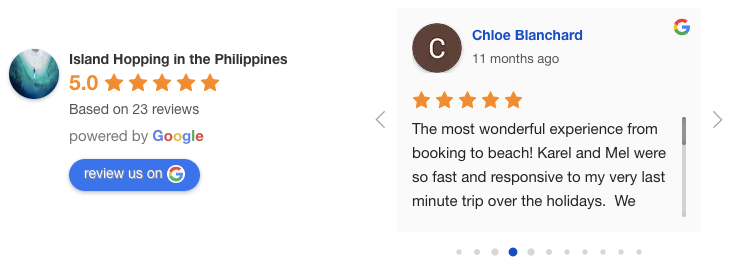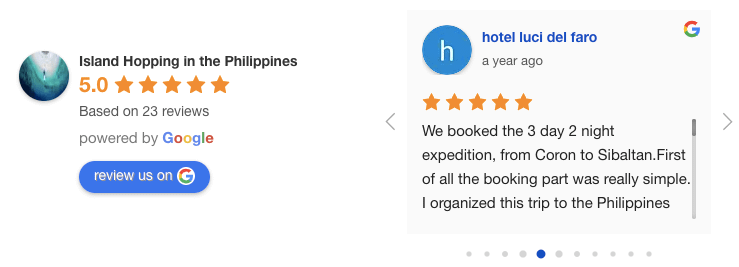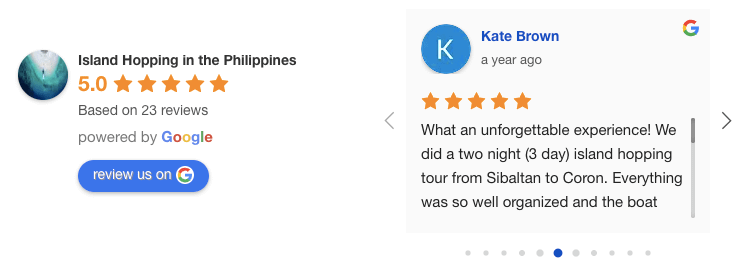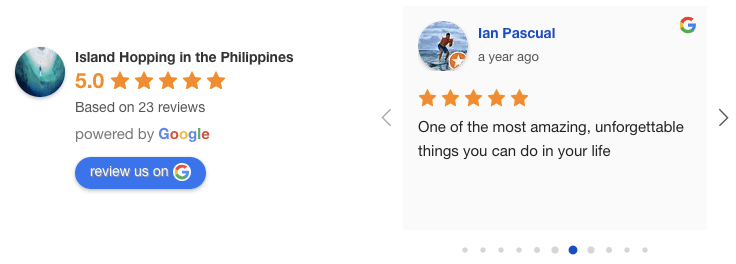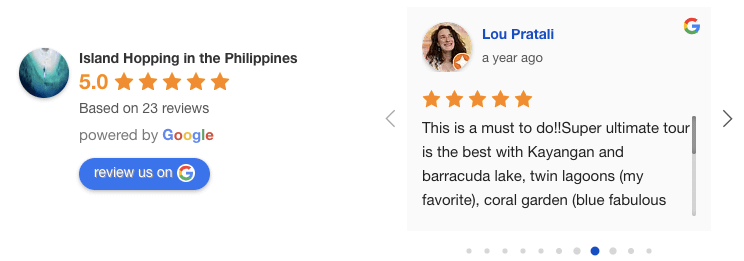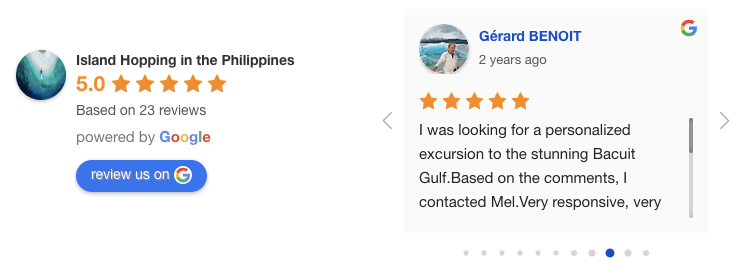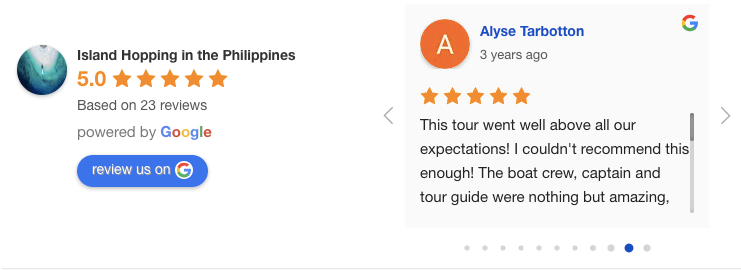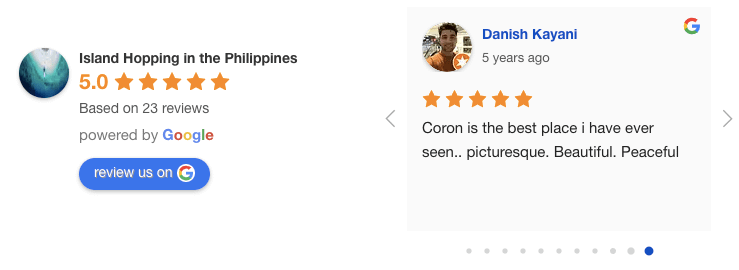Info about Palawan
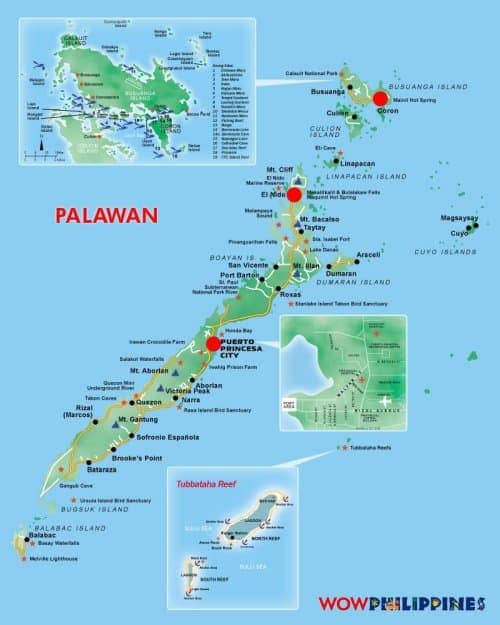
Referred to as the “Amazon of the ocean”, the Palawan area is one of the most naturally abundant regions of the world. It’s waters are so clear that you will be passing many pearl farms on our boat tours, since pearls require crystal clear waters to grow. Palawan is located at the heart of the Coral Triangle, a critically important bioregion that’s home to the highest levels of marine biodiversity on the planet. The region provides for 80% of the country’s seafood supply and is rapidly growing into one of the country’s top tourist destination.
Palawan has been voted three years in a row as the best island in the world. To the left is a map of Palawan and below are links to individual areas. For tips on how to travel through the Palawan area, check out my suggested travel itinerary. We believe the very best part of the Philippines is our custom private or group boat tours between El Nido and Coron. 52 paradise beach islands along the way, clearest waters in the world, fantastic snorkeling and a remote area to experience native Filipino life off the beaten path.
On this page:
- A legend is born (general mythology) – directly below
- History
- Nature
- Mangroves
- Palawan mythology
- Folklore
- How to get there
- Links to our other pages about Palawan
History and Interesting Facts About Palawan
A LEGEND IS BORN
A long time ago, the Philippines was apparently one single land. During this time there was a fierce warrior named Pili, named as such because he owned a pili (local nut) farm.
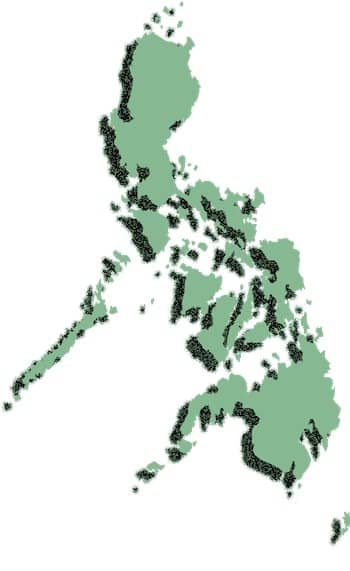 He also called the land Pinili (“The Chosen One”). Pili had a lover named Pinas, with whom he lived a happy life until the arrival of foreign invaders. Being a brave soldier, every day he and his army fought relentlessly against the invaders, remaining unbeaten for a long time due to his mastery of the native long sword, or “tabak”, with the hard wooden shield called “panangga.”
He also called the land Pinili (“The Chosen One”). Pili had a lover named Pinas, with whom he lived a happy life until the arrival of foreign invaders. Being a brave soldier, every day he and his army fought relentlessly against the invaders, remaining unbeaten for a long time due to his mastery of the native long sword, or “tabak”, with the hard wooden shield called “panangga.”
They were successful for some time, until the inevitable day when massive ships arrived armed with canon. These lethal balls destroyed Pili’s defense lines, driving the freedom fighters into the hills.
The foreign invaders outfought the locals with their advanced technology, guns and swords, but Pili held his ground despite being highly outnumbered and with a wounded army to support him.
The legend goes that he looked up to the sky, with his sword in one hand and shield in the other, and whispered a prayer to their god Bathala. At once Bathala answered Pili’s prayer by proclaiming, “This is my chosen land in the far east!” He stomped down with his great foot to create cracks in the land which swallowed the invaders. The cracks then spread to divide the land into several islands in the form of a warrior positioned in a fighting stance. The Visayas form Pili’s shield while Palawan makes his sword. With Pili and Pinas both mysteriously disappearing during this event, the newly formed land was called Pilipinas, or the Philippines.
Traditional Palawanese music taught to village children.
The above video is of a cool dude I met who was intrigued by my amateur viola playing and enjoyed my accompaniment with his traditional Palawanese music. He was active in promoting its preservation and was teaching to the children in the village I was staying at the time. I got a strong sense of his desire to maintain the local traditions, and now, years later, working on these pages for our boat tours , I discovered there is also a rich history of its mythologies. Below I have compiled some random excerpts of these traditions with links to their sources.
SOME HISTORY
Whether or not the entire land was joined at one point, it is true that there did exist a land bridge with Borneo. For which reason a lot of the locals are descendents of the Indonesians.
But other nations have populated the island of Palawan, so that by the time the Spanish colonialists arrived in 1521, Palawan was already quite developed and trading actively with the Chinese, Japanese and Borneans.
Actually, the coral islands of Palawan were once home to the first human settlements in Southeast Asia. In ancient caves hidden within jungle-clad limestone cliffs, archaeologists have discovered 47,000-year-old artifacts which can be traced through time to today’s island cultures.
The origin of the name Palawan is uncertain, possibly derived from the Chinese word “Pa-Lao-Yu”, or “Land of Beautiful Harbors.” Others think it comes from the Indian word “Palawans” (“Territory”). However, most think it comes from the Spanish word “Paragua”, because Palawan looks like a closed umbrella.

Tabon Cave complex
In 1962, a team of anthropologists unearthed fossils at Lipuun Point (now known as the Tabon Cave complex) that were classified as those of Homo Sapiens and believed to be 22,000 to 24,000 years old. These findings attributed the island as the Cradle of Philippines Civilization.
The inter-racial nature of Palawan, with its close proximity to other cultures, has created a unique mix among the Palawanese in terms of their appearance, mythology, culture and language.
 There are some 1,700 islands in the Palawan region, and their individual isolation has allowed them to develop differently, customs being handed down by word from generation to generation.
There are some 1,700 islands in the Palawan region, and their individual isolation has allowed them to develop differently, customs being handed down by word from generation to generation.
The primary island of Palawan has almost 2,000 km (about 1,200 miles) of coastline dotted with islets, rocky coves and sugar-white sandy beaches.
It is the locals’ tradition to revere nature like a deity, for which reason there has been a tendency during the region’s development to preserve the vast stretches of virgin forests that carpet its chain of mountain ranges. The highest peak is Mount Mantalingahan at 6,843 feet (2,086 m).
At 425km long (40km at its widest and 8.5km at its narrowest), the island also harbours a variety of climates, torrential rains bombarding the northern part during the months of July and August, while the east coast has a few months of short dry weather, the rest somewhat mild, and the south virtually free from tropical depressions.
The average maximum temperature is 31 degrees C with little variation all year – a perfect tourist destination.

Because of the island’s close proximity to Borneo, its southern portion fell under the control of the Sultanate of Brunei for more than two centuries, who introduced Islam.
There are 52 languages and dialects in the province, with Tagalog being spoken by more than 50 percent of the people.

The Spaniards colonialists experienced pockets of resistance but most of the country eventually turned Roman Catholic, with some leniency to local traditions, the Philippines, with its population of 100 million, now the greatest representative of that religion at 85% of the population. But Islam influence still reigns in the country’s southern region, although all of Palawan has been converted.
With Spain embroiled in its own continental disputes back home, after two centuries of rule it eventually surrendered these lands to the Americans for a sum of 20 million USD. The Americans implemented many improvements in government, promoting education, medical assistance, agriculture and tribal minorities’ rights.
NATURE
With its rich natural diversity and respect towards it by the locals, renowned underwater explorer Jacques Cousteau described the province as having one of the most beautiful seascapes in the world.
In 2007, the province has been rated by National Geographic Traveler magazine as the best island destination in the East and Southeast Asia region, or the 13th best island in the world having “incredibly beautiful natural seascapes and landscapes and one of the most biodiverse (terrestrial and marine) islands in the Philippines.”
It also sports one of the richest fishing grounds in the country, supplying about 45% of Manila’s demand for fish and other seafood. In fact, one of our island destinations is a major supplier hub, so be prepared to stuff yourself with the sea’s bounty for next to nothing!
Pearl diving also used to be a significant economic activity for Palawan, in 1934 the island producing the world’s largest pearl at 240 millimetres (9.4 in) diameter, the Pearl of Lao Tzu.
Its landscape resonates with the songs and flutter of more than 200 bird species, 600 kinds of butterflies and 1500 host plants.

Tubbataha Reef National Marine Park
Thanks to the nature-loving respect by the locals (they even have a hospital for crocodiles), the island boasts two UNESCO World Heritage sites: the Tubbataha Reef National Marine Park and the Puerto Princesa Subterranean River National Park, making Palawan one of the most popular tourist destinations in the Philippines.
Another popular destination is Coron, a smaller island just to the north. With 12 WW2 Japanese warships sunk offshore, this region has been listed in Forbes Traveler Magazine’s top 10 best scuba sites in the world.

The magical Coron Island
The island is also home to 44,500 hectares of mangrove forest, comprising 40% of the country’s total.
These qualities and the fact that this is the calmest region of the Philippines, both in terms of climate extremes and impoverishment, make this an ideal tourist destination.
MANGROVES
Having experienced a few mangrove river cruises and the respect of locals for these great trees, I felt I could conclude this article with a brief description of this amazing work of nature.
Mangroves are a crossroad where oceans, freshwater, and land realms meet. They are among the most productive and complex ecosystems on the planet, growing under environmental conditions that would quickly kill ordinary plants.

Mangrove forests provide protection and shelter against extreme weather events, such as storm winds and floods, or even tsunamis. Mangroves absorb and spread out tidal surges during these events, since a mangrove stand of 30 trees per 0.01 hectare with a depth of 100 m can reduce the destructive force of a tsunami by up to 90%.
Mangrove forests are rich in biodiversity, providing a habitat for a wide variety of animal and plant species. They are dynamic areas, rich in food. Live and decaying mangrove leaves and roots provide nutrients that nourish plankton, algae, fish and shellfish. Many of the fish caught commercially in tropical regions reproduce and spend their time in the mangroves as juveniles or adults.
Mangrove River Cruise near to the Underwater River Cruise
near Puerto Princesa, Palawan
Mangroves absorb carbon by accumulation in living biomass and through burial in sediment deposits. With living biomass typically ranging between 100-400 tonnes/ha, and significant quantities of organic matter being stored in the sediments, mangroves rival the sequestration potential of rainforests.
Bangladesh has not lost sight of that logic, putting a great premium on the ability of mangroves to stabilize shores and trap sediments. A low-lying country with a long, vulnerable coastline, Bangladesh is also land starved, with a crushing population density of 2,500 persons per square mile (2.6 square kilometers). By planting mangroves on delta sediments washed down from the Himalaya, it has gained over 300,000 acres (120,000 hectares) of new land on the Bay of Bengal.
The measurements suggest that mangroves may have the highest net productivity of carbon of any natural ecosystem (about a hundred pounds per acre [45 kilograms per 0.4 hectares] per day) and that as much as a third of this may be exported in the form of organic compounds to mudflats. Mangroves, it seems, are carbon factories, and their demolition robs the marine environment of a vital element.

Mythology
The Biangonan are small humans with black skin with feet pointing backwards. Actually, I was surprised that there are similar myths in many cultures, such as of the Curupira of Brazil, who have feet pointing backwards to confuse their colonial predators, leading them to the source of their journeys than their eventual destinations. The Biangonan can transform into a human or pig so it could sneak into a village to consume another pig or human. Villagers can detect the presence of them by their rotting smell and light a large fire at night, believing they will ward them off as such. If the Biangonan devour a human, they eat every part of it but leave the jaw bone hanging in a tree.
 Art By: Charisse ‘Dadis’ Melliza
Art By: Charisse ‘Dadis’ Melliza
These Biangonan are capable of creating illusions and sounds like a high pitched whistle capable of scaring a driving their victims into madness.
A unique aspect of Palawanese mythology is that their main characters are children.

IMAGE: Eugenio, Damiana L. (2001), Philippine Folk Literature: The Epics, UP Press
Kudaman: An Oral Epic in the Palawan Highlands
Two cousins went to a river to fish, but one of them disappears. Her father, concerned for her, asks her husband to find her, but he shows no interest. So he sent a prayer to “the Young Man of the Cumulus Clouds, Känakän ät Inarak” for help, who ventures into the water to find a tiny nail of the daughter between the deepest teeth of the oldest crocodile. He proceeds to wrench this nail from the crocodile, bringing this back to her father, who promised the young hero her hand in marriage if he succeeded. On return, the daughter, who had been suffocating in a box, reappears as a sparkling bamboo and the house glittered like the rising sun.
Above: https://www.aswangproject.com/kudaman-summary/
SALAKEP, the spirits of epidemic sickness: Tagbanua (Tagbanuwa) Beliefs
For the northwest winds bring the feared salakap, the spirits of epidemic sickness, to earth.
In the Philippines the wind blows to the northwest half of the year (the rainy season?..), and in the opposite direction the other half. I noticed that, with each of these changes, the temperature changes slightly but I always develop a flu.
As in the rest of the world , the germs of small pox, dysentery, the flu and others of the European colonialists decimated local populations, adding to their mythology. There is also evidence of early influence from Hinduized Brunei, on the landmass of Borneo and which was connected to Palawan long ago by land.
THE SALAKEP
These sailed in a huge outrigger with the northeast winds to carry back those who have died of these diseases. The myth is that these Salakep planted a tree during the time of the northeast winds. Anyone catching a scent from the fragrance of its flowers would get sick. Several deities are associated with this tree and there are those who claim to see this outrigger in their dreams carrying the spirits of their deceased loved ones. The Salakep then paint the trunk of these trees with the blood of the dead to support the sky.

Salakep art by: Ma. Valentina Famela Telmo IG: @famskaartyhan FB: @famskaartyhan
SALAKEP MYTH:
A long time ago the Salakep lived with the Tagbanuwa and these two tribes were friendly. One day they decided to go fishing and agreed that they would break up into two groups. But the trail to the seashore was forked, so it was decided that whichever groups should arrive at the fork first would leave a special rice meal wrapped in local leaves on the trail, to show the second group which way to go.
However, the Tagbanuwa instead decided to play a little trick on the Salakep by filling the leaves with their own feces. Unfortunately, when the Salakep discovered their trick, they found the contents aromatic and decided to eat it anyway, due to their hunger. However, they found it tasted good and surmised that, if their excrement tastes this good, their flesh must also taste even better. So they decided to eat them all!
Once they got to the beach they ate all of the fishing Tagbanuwa except for a man and woman, then proceeded to their village and devoured all those they found there. Then they returned to the two survivors and instructed them that they will not eat them under the condition that they will hold a “runsay” once a year, which is at the second night of a full moon in December.

Salakep art by: Ma. Valentina Famela Telmo IG: @famskaartyhan FB: @famskaartyhan
Tagbanua (Tagbanuwa) Cosmology: Multi-Layered Universe, Deities, Diwatas and Creation Myths

Illustration by Sergio Bumatay III From the book “Panyáan: Three Tales of the Tagbanua”
CREATION MYTH:
The deities created stone, but the stone could not speak. They they created the earth. The earth was able to speak and became a man*, the Tagbanuwa. So the deities gave this man fire, iron, tinder, as well as rice and rice-wine. Once the people had rice-wine they were able to call on the deities and spirits of their deceased loved ones**. Rice wine is found only on the earth among the living and is greatly desired by the deities and the spirits of the dead, making them easily invoked when it is ritually offered.
*Perhaps an interesting side note is a footnote in the Bible states that Adam was derived from the word Adamah, which means ground.
**Note that hard alcohol is referred to as “spirits”.

Illustration by Sergio Bumatay III From the book “Panyáan: Three Tales of the Tagbanua”
Author:
A Canadian born descendant of Scottish immigrants who founded The Aswang Project in 2006, after which he set out on a 5 year journey with his Filipina wife of 20 years to make the 2011 feature length documentary THE ASWANG PHENOMENON – an exploration of the aswang myth and its effects on Philippine society.
Palawan Folklore

According to folklore, Puerto Princesa was named after a princess-like maiden who could be seen in the area on certain nights of the year. Palaweños is the word for aquatic animals and is closely associated with folktales.
One of the favourite folktales told by locals is of a local fisherman whose boat was flipped upside down due to a sudden, strong wind. He floated on a piece of styrofoam for hours and was about to give up after exhausting himself trying to get to shore, but a pod of about 30 dolphins with a pair of whales came to his rescue, gently nudging him back to dry land.
https://groupmindorawan.wordpress.com/2015/03/10/folklore/
Getting There
Palawan is the nicest part of the Philippines and most relaxed tourist destination.
To get to Palawan you either need to fly in from Manila to Puerto Princesa or El Nido. Puerto Princesa is the island’s largest city and worth a one night stop-over due to surrounding highlights.
One way tickets are about half price. Most travelers fly into Princesa and either fly out of Coron, which is also possible, or take the once-a-week ferry from Coron to Manila. If you do take this route, make sure to drop by and say hello here in Linapacan – proclaimed clearest waters in the world and so many undeveloped islands to explore.
Or you can join or book one of our private custom Palawan boat tours between El Nido and Coron. Tons of paradise beach islands to see along the way, excellent snorkeling in crystal clear waters, caves to explore, Spanish fortress and much more. Completely off the beaten path!
Experience the thrill of island hopping in the Philippines
Interesting facts and history about the Philippines | Visayas
Explore the Philippines
Links to our various pages on the Palawan area:
Pages
- About Palawan, Philippines
- Accommodation
- Banca ferries boat safety between El Nido, Linapacan and Coron
- Boat Tours Trip between El Nido and Coron
- Booked
- Contact
- Coron Town
- Crystal Reiki Theta Massage Healing
- Culion
- Customer reviews of our boat tours and services
- Delux tent (B for Bohemia)
- El Nido
- El Nido Private Boat Lagoon Tours
- FAQ
- Half Way North
- Hammocks and under the stars
- Hunt for Beach Paradise
- Join or form a group boat tour between El Nido and Coron
- Larger tent the main camp (A for Alpha)
- Links
- Music Festival
- Navigation
- Patoyo Kitesurfing Eco Nature Camp
- Patoyo Paradise
- Payment
- Payment2
- Photos
- Pical on Iloc Island
- Private Boat Tour Prices Cost between and in El Nido, Coron and Balabac
- Private Underground River Tour in Sabang (Puerto Princesa)
- Puerto Princesa
- Sample Page
- San Fernando
- San Miguel, Linapacan
- Services
- Sibaltan – a quaint archeological village
- Small tents
- Store Action
- tags
- Tent Area C (Community)
- The main hut
- Trekking
- Wakeboarding and wakesurfing in the Philippines, Linapacan
- Wakeboarding and Water Skiing by Speed Boat
- Weather forecast
Posts by category
- Category: accommodation
- Category: aff
- Category: boat operator
- Category: Boat Stops
- Paradise Beach
- Turtle Sanctuary
- Pasandigan Beach
- Nat-Nat Beach
- Exploring South Entalula: A Diver’s Paradise
- The Serenity of Small Lagoon in El Nido
- The Beauty of Cadlao Island: A Secret Paradise in El Nido
- Shimizu Island: Discovering its Beauty and Mystery
- Unveiling the Majestic Cathedral Cave: A Must-See Boat Stop in El Nido’s Island Hopping Tour
- Payong-Payong Island: A Tranquil Oasis in El Nido, Palawan
- Unveiling the Enchantment of Secret Lagoon in El Nido’s Tour A
- Big Lagoon: A Must-Visit Island Hopping Destination in El Nido, Palawan
- Smith Beach in Coron, Palawan
- Calauit Safari Park: The Ultimate Family Adventure in Coron, Palawan
- Ditaytayan Island: A Hidden Gem of Coron, Palawan
- Skeleton Ship Wreck in Coron, Palawan: An Underwater Adventure of a Lifetime
- Atwayan Beach in Coron, Palawan: A Tropical Paradise Unveiled
- Exploring the Enchanting Siete Pecados in Coron, Palawan: Unveiling Nature’s Wonders
- Banol Beach: Coron’s Hidden Paradise with Sunset view
- Barracuda Lake, Coron
- El Nido to Coron Island Hopping Boat Tours
- Marriage Proposal Package in Palawan
- Combination Tour – El Nido plus Multiday Tour (Sibaltan to Coron)
- Malcapuya Island
- Coron Boat Tours
- Banana Island and Resort
- Twin Lagoons, Coron
- Kayangan Lake, Coron
- Araw Beach
- Boat Tour Negatives and How to Ensure a Successful One
- Personality Compatibility Test
- Eli Cave
- Barangonan
- Calacala
- Calibangbangan
- Takling
- Sitio Eli
- Category: Boat Tours
- Fishing with speargun and other means in Palawan
- Scuba Diving in Sibaltan, El Nido
- Discovering Sea Turtles in the Philippines: Top Spots in Palawan and Beyond
- Where to See Manta Rays in the Philippines: Best Spots in Palawan and Beyond
- Sea Cow or Dugong Snorkeling in Coron, Palawan, Philippines: A Unique Wildlife Experience
- Sand Island Boat Tours
- Multiday group tour expeditions schedule between El Nido and Coron
- Tubbataha Reef and Tour Package
- Seven Commando Beach: A Tropical Paradise in El Nido, Palawan
- Best snorkeling sites in Palawan: between El Nido and Coron
- Coral Gardens of Coron: An Unforgettable Island Hopping Boat Tour in Palawan
- Discover the Tropical Paradise of Coron: Your Ultimate Vacation Destination
- Balabac Island, Palawan – Island Hopping Boat Tour Guide
- Top 5 Spots You Must Visit In Coron, Palawan
- Speedboat for a speed boat tour or transfer between El Nido and Coron
- Romantic Getaway Vacation Destinations in the Philippines
- Luxurious catamaran yacht boat tours between and around El Nido and Coron
- Sibaltan day tour
- Exploring Caves and Shipwrecks in Black Island, Coron, Philippines
- Custom Private Scuba Diving Reefs and Wrecks in Coron, Palawan
- Sibaltan Island Hopping Eco Tours
- Coron Escapade Tour
- All-inclusive ten day return trip from Manila to Palawan for 10,000pesos ($200)
- Category: Boat Trips Tours
- Discovering Blacktip Reef Sharks: An Unforgettable Experience Between El Nido and Coron, Palawan
- Survive and Thrive: The Ultimate Island Survival Castaway Experience in Palawan
- Intimate Elope Wedding in Coron
- Combination El Nido and/or Coron boat tours with multiday expedition in between
- Sample Itineraries
- Best Spots and Tips Before You Go to El Nido
- Tips on Choosing Boat Tours in Coron
- Coron Expedition
- Spanish fortress and cliff diving in Linapacan
- Magransing Island: An Underrated Tropical Island in Palawan
- Maosonon Island: Unspoiled Tropical Island
- Bulog Dos
- Category: coron
- Category: Explore
- Private van transfer in Palawan
- Nacpan Beach
- Beautiful coral reefs in the Philippines
- CYC Beach Bliss: Sun, Sand, and Serenity
- Port Barton
- Your Ultimate Travel Guide to El Nido, Palawan in 2023!
- Calauit Island National Park: A Taste of the Wild West
- Bioluminescent Plankton and Stars in the Philippines
- The Ultimate Adventure Expedition Excursion Exclusive Private Boat Tour Between El Nido and Coron
- Coron Island: Everything You Need to Know
- Busuanga Island, Palawan’s Last Frontier
- The Calamian Islands of Palawan, an Absolute Must-See Paradise
- Category: FAQ
- Can I visit Camiguin Island and Palawan in the same trip?
- How long is the boat ride between El Nido and Coron?
- Palawan voted best island in the world
- Best Restaurants in Coron Philippines
- 2 – FAQ Questions
- 01 – FAQ Questions
- Can I do an island hopping tour from Manila to Puerto Princesa and stay in hotels with air conditioning?
- Category: Festival
- Category: Healing
- Category: log
- Category: motorbike
- Category: Patoyo
- Glamping in the Philippines, Palawan
- The high season is a success
- Finally met the property’s caretaker!
- D tent spots (Dimancal)
- Crossfit Personal Trainer on Beach
- Five months of rain, typhoons, bugs and misery
- Five months of development
- Successful kitesurfing at last!
- Some ventures off the island
- Owner Who What?
- Heading Back to the Island
- Move to Another Island
- First Kitesurfing Lesson and Rekindling of Old Online Business
- Kayaking
- Bamboo Gymnastics Workout Station
- Volleyball, Badminton, Basketball
- Sunrises and Sunsets
- Volunteer program
- Party in Manila, Ozzie brings 2 kiteboards
- Pros and Cons
- Second shopping spree – main hut on its way
- Exploring the island with GPS
- Getting Set Up – more details
- Getting Set Up
- And kitesurfing it is!
- A Change of Tack?
- Kitesurfing Paradise
- Finding the Dream Island
- Category: Photos
- Category: Pinterest
- 08 – Island hopping boat tour photos Palawan
- 07 – Island hopping boat tour photos Palawan
- 07
- 06 – Photos of island hopping boat tours in Palawan
- 05 – Photos of island hopping boat tours in Palawan
- 04 – Photos of island hopping boat tours in Palawan
- 03 – Photos of island hopping boat tours in Palawan
- 02 – Photos of island hopping boat tours in Palawan
- 01 – Photos of island hopping boat tours in Palawan
- Category: proposal
- Category: Reviews
- Category: Services
- Category: Tour Packages
- Category: trekking
- Category: Uncategorized
- Category: v
- The crystal clear waters of Palawan
- White sand beaches in the Philippines
- Tips on how to maintain a marriage with the opposite sex (from a male’s perspective)
- Philippines island hopping package itinerary tour and price
- Boat operator Jennifer
- A crazy trip around the world
- Private Custom Boat Tours Trip Expedition between El Nido and Coron
- Best Food in the Philippines
- Boat tours itinerary between El Nido and Coron
- Month plus trip
- Custom private or group kitesurfing or kiteboarding boat tour expeditions between El Nido and Coron
- Multi-day group boat tour expedition between El Nido and Coron
- Kayaking while Island Hopping on a Boat Tour
- Last months in the Philippines
- End of one big chapter, start of another
- Boatman Ghea
- Safety, weather and other conditions on our boat tours
- Katar Van Services
- Boat operator Rosela
- Sizes of boats
- Romantic Vacation – Honeymoon and Surprise Proposal in Palawan
- Opening bank accounts in North America
- On the road again
- The shit finally hits the fan
- Electrical system off the grid
- Opening a bank account and atm cash withdrawal for foreigners
- Single One Day Boat Trips Tours Between Sibaltan (El Nido) or Coron and Linapacan
- Seeking Yoga Retreat Teacher
- Alvin’s hut
- Negative Review Complaint about Smart Communications Incorporated (mobile phone operator)
- Linapacan Island Hopping Day Tour
- Suggestion letter to president Duterte
- Las Cabanas Beach Resort Room Prices
- Videos of Palawan boat tours between El Nido and Coron
- Rural Coron off the beaten path track
- F Camping Tent Spot (Frontier)
- E Tent Space (Emperador)
- Photos of Kayangan Lake and Twin Lagoons near Coron
- Obra Bar in Coron
- Travel reservation booking packages
- Kayaking in Palawan, Philippines
- Boat Operator Ben
- Boat Operator – Lando
- Boat Operator – Alvin
- Enjoy nature and the natural beauty of the Philippines
- Self-Sustaining Technology
- Category: Various
Tags
Important links:
- suggested tours and routes of the country. Design your own itinerary!
- Philippines by region and categories
- let us organise for you a custom boat tour in Palawan
Our reviews:

Home »
